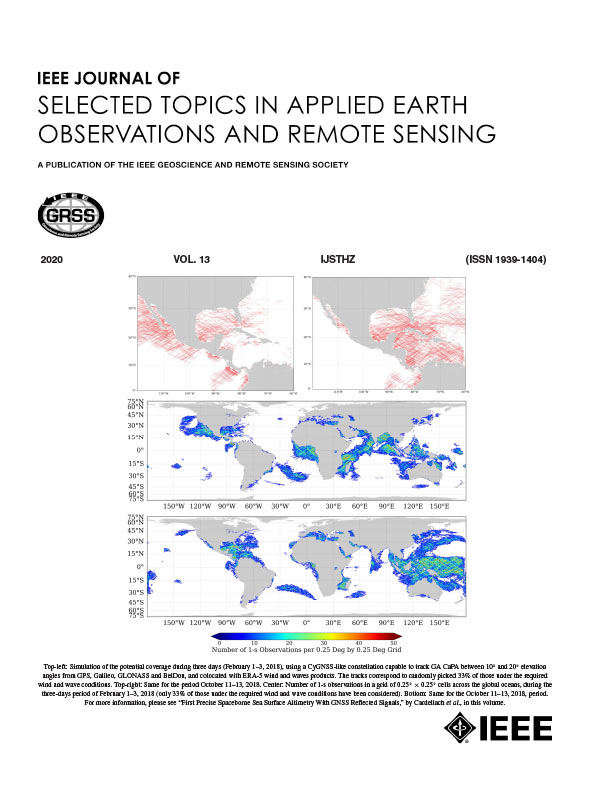Remotely Sensed Water Quality in Qatari Coastal Waters Between 2002 and 2022
IF 4.7
2区 地球科学
Q1 ENGINEERING, ELECTRICAL & ELECTRONIC
IEEE Journal of Selected Topics in Applied Earth Observations and Remote Sensing
Pub Date : 2024-09-03
DOI:10.1109/JSTARS.2024.3454092
引用次数: 0
Abstract
Over the past two decades, Qatar has undergone significant economic growth and development, yet little information is available on long-term trends in seawater quality around the Qatar Peninsula. This study analyzed spatiotemporal variations of remotely sensed optical water quality (OWQ) parameters in Qatari coastal waters between 2002 and 2022. These OWQ parameters, including chlorophyll-a concentration (Chla), turbidity (Turb), and Secchi disk depth (SDD), along with sea surface temperature, were derived from Moderate-resolution Imaging Spectroradiometer (MODIS)/Aquaobservations after applying an optically shallow-water mask. Additionally, changes in floating algae scum density, an indicator of harmful algal blooms (HABs), were derived from MultiSpectral Instrument (MSI)observations. Strong nearshore–offshore gradients were generally observed for all OWQ parameters (multiannual mean Chla ∼ 0.6–3 mg m −3 ; Turb ∼ 0.2–3 FNU; and SDD ∼ 5–12 m). SDD was typically greatest in late spring and summer when Chla and Turb were relatively low. OWQ variability in the main territorial sea was mainly driven by suspended sediments, while in the broader Exclusive Economic Zonewas driven by algal blooms. HABs dominated by2002 年至 2022 年卡塔尔沿海水域水质遥感情况
在过去的二十年里,卡塔尔经历了显著的经济增长和发展,但有关卡塔尔半岛周围海水水质长期趋势的信息却很少。本研究分析了 2002 年至 2022 年期间卡塔尔沿海水域遥感光学水质(OWQ)参数的时空变化。这些光学水质参数包括叶绿素-a 浓度(Chla)、浊度(Turb)、Secchi 圆盘深度(SDD)以及海面温度,均来自应用光学浅水掩膜后的中分辨率成像分光仪(MODIS)/水观测数据。此外,浮游藻类浮渣密度的变化(有害藻华(HABs)的指标)也来自多光谱仪器(MSI)的观测数据。在所有 OWQ 参数(多年平均 Chla ∼ 0.6-3 mg m-3;Turb ∼ 0.2-3 FNU;SDD ∼ 5-12 m)中,一般都能观察到较强的近岸-近岸梯度。SDD 通常在春末和夏季最大,此时 Chla 和 Turb 相对较低。主领海的 OWQ 变化主要受悬浮沉积物的影响,而在更广泛的专属经济区内则受藻华的影响。在较深(>20 米)的水域中,经常可以观察到以 Margalefidinium polykrikoides、Noctiluca scintillans 和 Trichodesmium spp.为主的有害藻华。尽管卡塔尔近年来经济发展迅速,但仍观察到 Chla 和 Turb 的下降以及 SDD 的增加。然而,卡塔尔沿岸水域的变暖速度为 0.64 ℃/十年,比邻近的红海和北阿拉伯海水域快 2-3 倍,比全球海洋快 8 倍。这种热应力可能对海洋生态系统及其提供的服务构成未来的挑战。
本文章由计算机程序翻译,如有差异,请以英文原文为准。
求助全文
约1分钟内获得全文
求助全文
来源期刊
CiteScore
9.30
自引率
10.90%
发文量
563
审稿时长
4.7 months
期刊介绍:
The IEEE Journal of Selected Topics in Applied Earth Observations and Remote Sensing addresses the growing field of applications in Earth observations and remote sensing, and also provides a venue for the rapidly expanding special issues that are being sponsored by the IEEE Geosciences and Remote Sensing Society. The journal draws upon the experience of the highly successful “IEEE Transactions on Geoscience and Remote Sensing” and provide a complementary medium for the wide range of topics in applied earth observations. The ‘Applications’ areas encompasses the societal benefit areas of the Global Earth Observations Systems of Systems (GEOSS) program. Through deliberations over two years, ministers from 50 countries agreed to identify nine areas where Earth observation could positively impact the quality of life and health of their respective countries. Some of these are areas not traditionally addressed in the IEEE context. These include biodiversity, health and climate. Yet it is the skill sets of IEEE members, in areas such as observations, communications, computers, signal processing, standards and ocean engineering, that form the technical underpinnings of GEOSS. Thus, the Journal attracts a broad range of interests that serves both present members in new ways and expands the IEEE visibility into new areas.

 求助内容:
求助内容: 应助结果提醒方式:
应助结果提醒方式:


